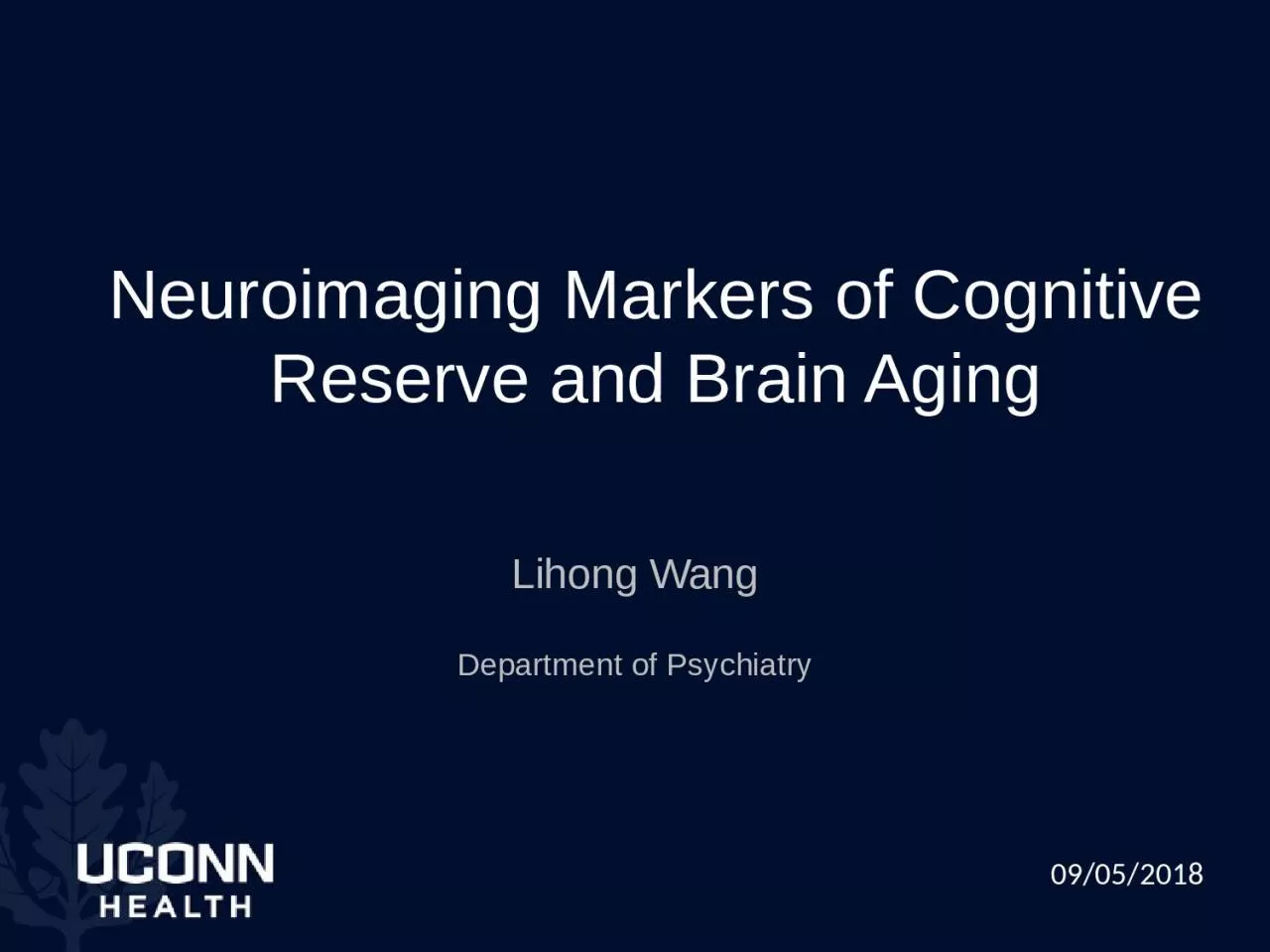

Lihong Wang Department of Psychiatry 09052018 Overview Neural Compensatory Activation amp Cognitive Reserve Semiquantitative Measure of Neural Compensation Physical Exercise amp Neural Compensatory Activation ID: 1030905
Download Presentation The PPT/PDF document "Neuroimaging Markers of Cognitive Reserv..." is the property of its rightful owner. Permission is granted to download and print the materials on this web site for personal, non-commercial use only, and to display it on your personal computer provided you do not modify the materials and that you retain all copyright notices contained in the materials. By downloading content from our website, you accept the terms of this agreement.
1. Neuroimaging Markers of Cognitive Reserve and Brain AgingLihong WangDepartment of Psychiatry09/05/2018
2. OverviewNeural Compensatory Activation & Cognitive ReserveSemi-quantitative Measure of Neural CompensationPhysical Exercise & Neural Compensatory Activation Future Directions
3. Park et al, Psychol Aging, 2002; Dialogues Clin Neurosci. 2013 Cognitive Aging
4. Structural Changes across Life SpanSowell et al, Nat Neurosci, 2003
5. Over-Activation in Older AdultsHAROLD (hemispheric asymmetry reduction in older adults) model – Cabeza, 2002
6. Compensatory or DeficiencyCabeza, NeuroImage, 2002Rossi, et al, J Neurosci,2005
7. Task demandsCompensation SuccessfulCompensation FailureOlderYoungerBrain Activation
8. The CRUNCH model(Compensation-Related Utilization of Neural Circuits)Mattay, et al. Neurosci Lett 2006
9. ReserveCognitive ReserveBrain ReserveBrain StructuresBrain FunctionReserve CapaticyStern Y, Neuropsychologia. 2009; Lancet Neurol. 2012
10.
11. Quantitative Measure of Cognitive Reserve-Decomposing Episodic Memory Variancex1: education, sexx2: gray matter volume, hippocampus volume, WMHReed B.R., et al, 2010 Residual Variance in episodic memory performance that remains after accounting for demographic factors and brain pathology (whole brain, hippocampal, and white matter hyperintensity volumes)High Residual Reserve ∞ higher reading ability, lower likelihood of MCI, lower odds of dementia conversion independent of age, and less decline in language abilities over 3 yearsZahodne, et al, J Int Neuropsychol Soc, 2014
12. Aging/NeurodegenerationCompensatory NetworksNetwork-based Neural Compensation Model
13. Neuropsych test MMSEHVLT-RImmediate and Delayed Story Recall WAIS-III Digital symbol Trail Making Test Stoop testMood State POMGait Speed 6MWTParticipants: healthy older adults > 60 yrs N=26
14. Cognitively Challenging TaskJi et al. Front. Aging Neurosci., 2018
15. Task ActivationsEncodingRetrieval
16. Spatial ICA Correlations to the hemodynamic response the task design Networks’ time courses showing significant correlations to task design (p<0.001) were counted as task-related networksNumber of activated networks of each subjectActivation rate of each network26 subjects15 componentsNeural Networks – Independent Component Analysis (ICA)
17. Validation of Threshold
18. Compensatory capacity was defined as the number of activated networks in the challenging task controlled with core networks’ volume.Compensatory Capacity
19. x1: education, sexx2: gray matter volume, hippocampus volumeReed B.R., et al, 2010Compensatory Capacity & Cognitive Reserve1.510.50-0.5-1Cognitive ReserveFewerNetworkMoreNetwork25-50%50-75%MoreNetworkFewerNetworkGood PerformancePoor Performance
20. Compensatory capacityWorking Memory21171395-3-2-1012r16= 0.528, p=0.035700300500100-2026 MWTr16= 0.660, p=0.015Compensatory capacity
21. The Effect of Physical Exercise on Neural Compensation
22. Participants: healthy older adults > 60 yrs N=25 Dance trainingFirst T1/fmri scanSecond T1/fmri scanOutput measuresCognitionGait speedMood stateWeek0Week6Ji et al. Int J. Geriatric Psychiatry, 2018
23. Memory function
24. X-boxMemory functionGait SpeedPhysical Exercise Increases Gait Speed, Memory, and Cognitive Reserve in Older AdultsMotor CorticesCerebellumPre-exercisePost-exercise0.350.650.760.94Activated ratio of motor corticesActivated ratio of cerebellumJ Int Geriatric Psychiatry, 201813121110 9 8 7 6 5Pre-exercisePost-exerciseLogical MemoryIndividual subjectAverage
25. SummaryWe proposed a new data-driven measure for neural compensatory capacity using a highly cognitive-demanding task and a brain network-based approach.We demonstrated that our neural compensatory capacity measure is correlated with cognitive function as well as gait speed.We also demonstrated that physical exercise may improve cognitive function through increasing neural compensatory capacity in older adults.
26. Motor System with Cognition & Aging
27. Ji et al. Front Aging Neurosci. 2017
28. Exercise Improved Executive Function and Memory
29. Structural MRI Results
30. Resting-State ALFFALFF change in Striatum / Caudate/Insula
31. Resting-State ReHoReHo change in Caudate/ThalamusReHo change in PCC / Precuneus
32. Functional Connectivity
33. Functional Connectivity
34. Correlation with Cognitive Improvement
35. Index of Aging 44-73 years
36. Index of Aging Actual Age (years)Predicted AgeUnpublished dataThe correlation of predicted age based on these imaging data and actual age was 0.92 in the training set, and was 0.72 in the test set.Random Forest Analysis
37. Index of Aging
38. Future Directions Validate our neural compensatory capacity measure in MCI, AD, and late-life depressionRefine index of aging- combines Random Forest imputation and LASSOClarifying the relationship between sensorimotor network with cognitive function
39. Resource of Attention Bias (RAB)RAB (Post-Pre Math)RAB (ATD – Control)RAB= FC (RAI-RDLPFC) + FC (RAI-PCC)
40. Stress level_ 24monthsRABr40=0.41, p=0.007RABr34=0.35, p=0.039Unpublished data
41. AcknowledgementNSFC 31271080Lanxin JiTsinghua UniversityXue ZhangHua GuoUCHCDavid SteffensKevin ManningONRC/IOLKeith HawkinsGodfrey Pearlson1R01MH098391-01A1
42. Thank you for your attention!!!